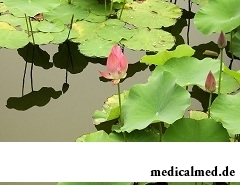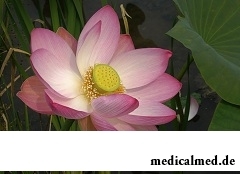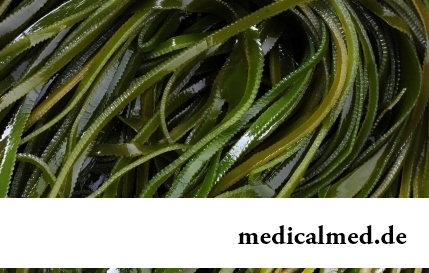





Lotus orekhonosny
Application instruction:
 The lotus orekhonosny is a perennial amphibious plant. The Russian interpretation of this plant sounds as "Komarov's lotus" or "the Caspian lotus". Karl Linney in 1753 gave to a flower the first description. Many east countries consider a lotus a sacred flower. In pictures of most of the English gods the white lotus which symbolizes the power is represented. To the Buddhism in China believed in existence of paradise, it was identified with a reservoir and lotuses, each flower was an embodiment of the died soul.
The lotus orekhonosny is a perennial amphibious plant. The Russian interpretation of this plant sounds as "Komarov's lotus" or "the Caspian lotus". Karl Linney in 1753 gave to a flower the first description. Many east countries consider a lotus a sacred flower. In pictures of most of the English gods the white lotus which symbolizes the power is represented. To the Buddhism in China believed in existence of paradise, it was identified with a reservoir and lotuses, each flower was an embodiment of the died soul.
Characteristic
In the soft soil (very often - it is under water) there is an oblong, branched, fleshy root having a brown peel and couple of direct leaves.
Flowers of an orekhonosny lotus belong to a surface part. They are on a stalk pedicel on which there are no leaves. The flower has diameter of 25-30 cm and has pleasant, weak aroma.
Lotuses happen a lilac, yellow-pink and white-yellow shade. Leaves at a flower large, their diameter reaches 70 cm. Buds are dismissed only at a sunlight, and for the night they are again closed. The plant can have dark seeds or light. The lotus orekhonosny breeds seeds. Most often he can be met on the Philippine Islands, on the island of Sri Lanka, in China, Japan, Indonesia, India, Iran, Australia, New Guinea, Vietnam, Azerbaijan. The lotus is grown up artificially for decoration of reservoirs, and also in the medicinal and food purposes.
Use
In the medicinal purposes, in cosmetology and when cooking widely use both a stalk, and roots, and flowers, and leaves, and seeds of a lotus orekhonosny.
It is considered that the lotus renders the good refreshing, calming, styptic, febrifugal, nutritious, anti-toxic and diuretic action. It is used both in traditional, and in traditional medicine. Found the broadest application in the Arab, Vietnamese, Indian and Tibetan medicine.
Roots and seeds of a plant can be used for treatment of diarrhea, diseases of a liver, kidneys and a spleen, dysentery, colitis, avitaminosis, pneumonia, sleeplessness, tachycardia, bronchial asthma, uterine and gastric bleedings, emission. These raw materials can be used as in prepared, and in the raw. Besides, leaves can become a basis of salads, and in combination with vaseline will help at burns.
Crude seeds contain a large amount of vitamins, fats, proteins and carbohydrates. It is noted that seeds comprise thiamin, pantothenic acid, folic acid, a pyridoxine, a niatsinovy equivalent. Also seeds contain many mineral salts: magnesium, potassium, calcium, phosphorus, manganese, sodium, copper, zinc and iron.
Roots of a lotus orekhonosny contain carbohydrates, proteins, fats, food fibers and a set of vitamins.
To prepare lotus broth, it is necessary to fill in with 1,5 glasses of water a tablespoon of the crushed roots. This mix is cooked minutes 5-7 on weak fire, and then filtered after an hour of insisting. Recommend to apply such broth three times a day on a half-glass to food (minutes for 10).
It is also possible to make effective ointment which will help at burns of a lotus. To make such ointment, it is necessary to fry thoroughly well crushed leaves to blackness, and after that to mix with vaseline. Apply ointment on an affected area of a body still warm the quiet vtiratelny movements.
Harm
Drugs with the maintenance of a lotus at chronic locks are contraindicated. Also the individual intolerance of components of a lotus orekhonosny can become the reason of various unpleasant effects.
The educated person is less subject to brain diseases. Intellectual activity promotes formation of the additional fabric compensating sick.

History of use of an anesthesia during operations contains more than 160 years. Annually in the world hundreds of thousands surgical вм are carried out...
Section: Articles about health
During foot walks blood moves on vessels more actively and one and all bodies are supplied with a large amount of oxygen. It affects the state of health of the person very positively....
Section: Slideshow
People know that thermal sources have salutary force long ago. Treatment by natural waters is one of the most ancient methods of disposal of the most different diseases. Bathtubs, souls, wrappings and inhalations, in combination with water reception inside help to improve a condition of the patients suffering from disturbances of work of a musculoskeletal system, bodies of digestive tract, cardiovascular, nervous, respiratory and secretory system, skin and endocrine п...
Section: Articles about health
A lot of things depend on a condition of a backbone in a human body, a backbone - not only a support for a body, it also contain...
Section: Articles about health
Feeding by a breast - the integral part of ideal motherhood allowing to come into contact with the kid and to create to it healthy immunity since early years. Nevertheless, this important process in life of mother and child can be saddened laktostazy − by a delay of milts...
Section: Articles about health
The sudden heat on all body which is followed by perspiration and a cardiopalmus – the phenomenon familiar to many people. Most often such states called by "inflows" result from nervous or physical overworks and disappear right after rest. However in certain cases similar reaction of an organism can speak about diseases which need treatment. What? About it below....
Section: Articles about health
Life of the modern child is extremely active and difficult. Information strain which is experienced by the school student and did not dream the pupil...
Section: Articles about health
At this plant there are a lot of names: tuberiferous sunflower, Jerusalem artichoke, solar root, earth pear. Contrary to popular belief, it is not an exotic plant at all. The wild girasol grows in a midland of Russia practically everywhere: at the edges of roads...
Section: Articles about health
It would seem, about it there can be no disagreements: water is necessary for a human body for normal life activity, and about how and when it should be drunk, all know. It turned out that the situation is not absolutely so: for many years there are very persistent delusions connected with this question. Let's consider the most widespread of them....
Section: Articles about health
For the city dweller the fitness is the most convenient sport. It is enough to acquire the subscription to the gym to receive to a toast...
Section: Articles about health
Visit of doctors – business not the most pleasant, and many people do not hurry to undergo necessary planned inspections. Such behavior is extremely thoughtless and improvident. Our health is necessary not only to us: wellbeing of darlings, children, grandsons and престар...
Section: Articles about health
According to doctors, more than a half of men of 25-50 years suffer from frustration of the urinogenital sphere, but the minority sees a doctor from them. And in vain - even the insignificant discomfort in the field of generative organs can serve as a symptom of an illness fraught with grave consequences for health. So - after 40 years - it is easy for most widespread disease of the sexual sphere of men to pass the first symptoms of prostatitis (weight in the bottom of a stomach, decrease in a libido), having written off for overfatigue and fatigue. Let's consider...
Section: Articles about health
(Xerostomia) many people consider feeling of a xerostomia small and easily removable inconvenience. This delusion...
Section: Articles about health
For the person who daily since morning gathers for work it is very important to wake up vigorous and ready by day of work. Actually, each of us experiences difficulties with this, at first sight, simple business from time to time. On a condition of an organism after ночн...
Section: Articles about health
Bees – really unique beings. Practically all products of their life activity are used by the person. Since the most ancient times medicinal properties of honey and other substances received in the course of beekeeping are known. The fact that all these products are recognized not only national, but also official medicine is especially significant. About influence and routes of administration of bee "drugs" the speech in this article will also go....
Section: Articles about health
Almost each of us during life faced dissatisfaction with own body. At such moments, as a rule, we beginning...
Section: Articles about health
The popular expression "run from a heart attack" became the motto of the people supporting active lifestyle. Moreover, run became a peculiar fashionable tendency: sales of racetracks and the accompanying goods for run are at permanently high level. Really...
Section: Articles about health
You are office worker, the driver, the fan of winter sports or do not think of life without bicycle? You lead a slow-moving life and you move on the city only on the car? You have no constant partner and you do not love the protected sex? Attention! You unambiguously are a potential target for prostatitis. It is not necessary to panic, it is necessary to work....
Section: Articles about health
The nature does not stand stagnation and monotony. It is known that tissues of a human body atrophy if do not receive necessary loadings...
Section: Articles about health
Such trouble as the milkwoman's attack, at least once in life happened almost to each woman. Prevalence of a disease is explained by the fact that the causative agent of an illness belongs to the so-called opportunistic microflora living on mucous an obol...
Section: Articles about health
They say that to ensure health and longevity of people it is obliged. Really, at competent approach to these questions, minimization of an adverse effect of many factors does not represent a special problem. Practically everyone has an opportunity to play sports, to pick up an optimum operating mode and rest, to adjust healthy food, to refuse addictions. It is more difficult to exclude hit in an organism of harmful substances through a respiratory organs: not all are able to afford to live in the area with хо...
Section: Articles about health
Eyes – unique body on the structure thanks to which the person obtains about 80% of information on the world around: about a form...
Section: Articles about health
The varicosity has familiarly many, statistically, this disease more than a half of all adult population. As a rule, the varicosis affects preferential superficial vessels, and is shown by characteristic cosmetic defects. Guo...
Section: Articles about health
Each of us repeatedly noticed that the people having the same passport age are sometimes not similar on one-years at all. One at the age of 40-45 years already looks almost an old man, and another and in 60 is young, vigorous and full of life. The matter is that the condition of our health depends not on the number of the lived years, and on degree of safety of an organism. This factor also defines biological age of the person....
Section: Articles about health
For residents of the countries of Southeast Asia various algas are an obligatory component of a daily diet. Their priest...
Section: Articles about health
What they, women? Beautiful, gentle, passionate and at the same time windy, gusty, and nervous. And what is stranger: have all these qualities of the woman at the same time. But here only the mood their time sharply changes on completely opposite: in the morning...
Section: Articles about health
When overcomes feeling of hunger, and an opportunity to have dinner fully is absent, having a snack − the meals, small on volume, stabilizing sugar level in blood comes to the rescue. The relation of nutritionists to having a snack more often negative, but only because as snack people choose the most caloric products with the increased amount of "bystry" carbohydrates: cookies, rolls, chips, candies. Nevertheless, the advantage of having a snack is obvious to weight loss: the person avoids strong feeling of hunger...
Section: Articles about health
